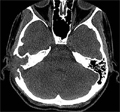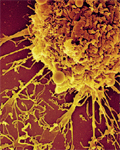The eLitMed.hu medical portal uses computer cookies for convenient operation. Detailed information can be found in the Cookie-policy.
Lege Artis Medicinae - 2006;16(07)
Content
[DIARRHOEA AND PSEUDOMEMBRANOUS COLITIS ASSOCIATED WITH ANTIBIOTIC TREATMENT]
[Antibiotic treatment is complicated by diarrhea in 5 to 25% of the cases. Its prevalence depends on the antibiotic used, the patient’s age, the concomittant diseases and the immune response. The severity of the diarrhoea is variable ranging from a mild self-limiting disease lasting for 1 or 2 days to a severe condition with high mortality. The diarrhea may result from a direct effect on the gut, but more commonly it is the consequence of changes in resident gut flora. Clostridium difficile is responsible for 10 to 20% of all antibiotic-associated diarrhea cases. The clinical presentation varies from asymptomatic carriage to fulminant pseudomembranous colitis. This latter typically develops as a nosocomial infection, mainly in patients treated with cephalosporins, amoxicillin-clavulanic acid combination or clindamycin. Risk factors are advanced age, severe underlying disease, treatment in an intensive care unit, long hospitalization and invasive medical procedures. The clinical picture is characterized by frequent, watery (occasionally bloody) diarrhea, abdominal pain, tenesmus, fever, weakness. Fulminant colitis develops in 3-5% of cases. The diagnosis is based on testing for C. difficile toxins, but in selected cases rapid diagnosis can be made by flexible sigmoidoscopy. The treatment consists of the withdrawal of the implicated antibiotic along with administration of oral metronidazole or vancomycin which target C. difficile itself. Most patients respond to this treatment; however, the mortality of fulminant cases or those with severe underlying disease is high. Fifteen to 20% of the patients relapse and management of the recurrent cases is difficult. Combination treatment, probiotics and/or passive immunization may be used. Preventive measures include judicious use of antibiotics and aggressive control of the spread of C. difficile infection.]
[ANTIBIOTIC TREATMENT OF SKIN AND SOFT TISSUE INFECTIONS - THE USE OF RESPIRATORY FLUOROQUINOLONS]
[The paper reviews the classification and grading of skin and soft tissue infections and their most common pathogens. The recommended antibiotics are itemized taking into account their antibacterial and pharmacokinetic properties and side effects. The use of levofloxacin, an antibiotic that have so far been almost exclusively given in respiratory tract infections, is noted as a new therapeutic option. In unusually severe infections hospitalisation of the patient can be avoided since levofloxacin can also be prescribed by general practitioners. Both published data and the author's own experience suggest that levofloxacin may gain a prominent role in the treatment of skin and soft tissue infections both in primary and specialist care.]
[NONINVASIVE MECHANICAL VENTILATION IN CHRONIC OBSTRUCTIVE LUNG DISEASES WITH ACUTE OR CHRONIC RESPIRATORY FAILURE]
[Over the past decade, the use of noninvasive ventilation in the setting of acute exacerbations of chronic obstructive pulmonary disease (COPD) has gained popularity, and is recommended by evidence-based guidelines. The evidence that it should be effective in chronic COPD is much weaker, and large, prospective, randomised, controlled studies that would also provide a guide for the selection of the best candidates, are still lacking. It has bee established, however, that home mechanical ventilation is certainly beneficial for a well-defined subgroup of patients. This includes the so called “blue bloater” patients (with hypercapnia and polyglobulia), other cases with increased hypercapnia, and patients with "overlapping" syndrome (COPD accompanied by sleep apnoe). Also, for patients with acute respiratory failure who refuse intratracheal intubation noninvasive mechanical ventilation remains the only choice. The past years have unequivocally proved the superiority of the positive pressure ventilation mode for either short term or long term use.]
[CONTROVERSIAL ISSUES IN THE TREATMENT OF OPERABLE CERVICAL CANCER]
[Wertheim hysterectomy as a baseline surgical treatment for patients with FIGO stage 1a2-2a cervical cancer was introduced in 1989 at the National Institute of Oncology, Budapest, Hungary. From then until 2002 when the results were first evaluated 308 such operations were performed. The average 5- and 10-year survival rates were 80% and 75%, respectively. Although these results are comparable to literature data, several issues concerning this group of patients remain to be solved. The participation rate in the Pap test screening programme covered by the national health insurance is only 30%. There is no national database on the current treatment of these patients that could help identify the necessary steps to be taken in order to improve the results. The number of radical hysterectomies performed a year in Hungary, or their outcome, is not known. The treatment scheme varies among the institutes and so does surgical experience. There is no consent regarding treatment policy, preoperative irradiation or chemotherapy, surgical technique, or postoperative management. The improvement of the participation rate in the screening programme, the use of prognostic factors to determine the most appropriate treatment, the role of minimally invasive and fertility-preserving surgery, the preservation of ovaries and the use of neoadjuvant chemotherapy are some of the further issues that need to be discussed. The first step should be data acquisition from all institutes in the country in order to develop and apply uniform treatment guidelines.]
[THE POTENTIAL ROLE OF THE SEMICARBAZIDESENSITIVE AMINE OXIDASE ACTIVITY IN THE DEVELOPMENT OF DIABETIC RETINOPATHY]
[Recent data suggest that the copper-containing semicarbazide-sensitive amine oxidase enzyme (SSAO) may play a role in vascular endothelial damage through conversion of certain endogenous monoamines, such as methylamine, into cytotoxic aldehydes, hydrogen peroxide and ammonia. SSAO is present in various human tissues and in the serum. Elevated SSAO activities have been reported in patients with both types of diabetes mellitus. We have demonstrated that the activity of serum SSAO is significantly higher in type 2 diabetic patients with high-risk proliferative diabetic retinopathy compared to those without retinopathy. Our clinical results support the hypothesis that elevated SSAO activity may be involved in the pathogenesis of microvascular diabetic late complications, such as retinopathy. The enzymatic conversion of the endogenous monoamines (e.g. methylamine, aminoacetone) into toxic aldehydes and hydrogenperoxide may be one of the possible mechanisms of the development of microangiopathy. Also, the vascular adhesion protein-1 (VAP-1) function of the molecule can cause leukostasis and leukocyte activation through increased leukocyte adhesion, resulting in worsening of the capillary circulation and hypoxia. Further prospective, larger studies are needed to elucidate the role of the possible association between serum SSAO activity and highrisk proliferative retinopathy in patients with type 2 diabetes. The pharmacological manipulation of SSAO activity might be an interesting new concept for prevention and treatment of diabetic retinopathy.]
[POSSIBLE TERATOGENICITY OF VAGINAL METRONIDAZOLE TREATMENT AND ITS EFFECT ON GESTATIONAL AGE AND PREVALENCE OF PRETERM BIRTH - CASE-CONTROL STUDY]
[INTRODUCTION - The primary aim of the study was to investigate the possibility of a teratogenic effect of vaginal metronidazole treatment during pregnancy. MATERIALS AND METHODS - Various congenital abnormalities and all (1-3) their matched controls were analysed in the population-based database of the Hungarian Case-Control Surveillance of Congenital Abnormalities between 1980 and 1996. The study group comprised 38 151 pregnant women who had newborns without any congenital abnormalities (control group) and 22 843 pregnant women who had newborns or fetuses with congenital abnormalities. Main outcome measures were analysed in 22 congenital abnormalities groups. The use of metronidazole during the second and third trimesters being common, the secondary objective of the study was to analyse the effect of vaginal metronidazole treatment (500 mg of Klion) on gestational age and birth weight in the control group without congenital abnormalities. RESULTS - The prevalence of vaginal metronidazole treatment during pregnancy was 1.7% in the case group (n=388) and 1.5% in the control group (n=570) (odds ratio (OR), 1.1, 95% confidence interval (CI): 1.0-1.3). Comparisons of cases and their matched controls showed an association between vaginal metronidazole treatment during the second and third months of gestation and congenital hydrocephaly (adjusted OR with 95% CI, 10.7, 1.1-104.5), but this was only based on five cases. The analysis of metronidazole treatment reported by the physicians did not confirm this association. After metronidazole use the mean gestational age was slightly shorter (by 0.1 week) and the mean birth weight was also slightly lower (by 40g) in the treated group. CONCLUSION - This finding should only be regarded as an indication for a possible association between vaginal treatment with metronidazole during pregnancy and congenital hydrocephalus. The results showed that vaginal metronidazole treatment alone was not able to prevent a possible vaginal infection that is associated with preterm birth, and that the prevalence of low birth weight was higher among treated women. The protective effect of metronidazole on preterm birth and low birth weight was not confirmed.]
[WEGENER’S GRANULOMATOSIS PRESENTING AS MASTOIDITIS: A DIAGNOSTIC CHALLENGE]
[INTRODUCTION - Wegener's granulomatosis has an uncertain pathomechanism, but is probably autoimmune in origin. In typical cases the mucosa of the nose, paranasal sinuses and of the lower respiratory tract, as well as the lungs and the kidneys are affected. Patients present with sinusitis, recurrent pneumonia or renal disease associated with microhaematuria, pyuria or azotaemia. Fever, polyarthralgia or polyarthritis may also occur. The underlying pathologic changes are necrotizing vasculitis, granulomas and parenchymal necrosis. The diagnosis is based on a combination of the clinical picture, microscopic findings and immunofluorescent demonstration of cANCA. CASE REPORT - A 27-year-old woman presented with symptoms of unilateral mastoiditis. In the following 7 months she underwent 7 operations in 4 hospitals for a locally progressive, destructive process of uncertain etiology showing a septic course. The clinical picture was not specific, the cANCA test was not definitive, and the histologic findings were initially interpreted as nonspecific inflammation. Repeated biopsies, multiple reviews of the microscopic specimens, consultations, differential diagnostic considerations, and, finally, the success of the treatment with corticosteroids and cyclophosphamide led to the diagnosis of Wegener’s granulomatosis. Currently the patient has been in remission for 32 months. CONCLUSION - The definitive diagnosis of Wegener’s granulomatosis, particularly of its localized or limited form, may be problematic despite well-defined diagnostic criteria. Setting up the correct diagnosis may take months or years. In case of unusual respiratory or otological symptoms, and in view of ineffective medical or surgical treatment, Wegener’s granulomatosis has to be considered. An atypical clinical picture, inconclusive histologic, radiologic and laboratory findings warrant the need for close collaboration of various specialists. This is particularly important since state-of-the-art therapy of Wegener’s granulomatosis promises a favourable prognosis.]
[ACTINOMYCOSIS MIMICKING LUNG CANCER]
[INTRODUCTION - The mortality of lung cancer is high, but with early diagnosis the disease can often be cured. The differential diagnosis of pulmonary carcinoma is widely diverse. CASE REPORT - In a 53-year-old male patient, who had been successfully treated for pneumonia complicated with thoracic empyema, both a CT scan and bronchoscopy raised the suspicion of a malignant tumour. Brush cytology was inconclusive; it raised the possibility of malignancy but was not felt diagnostic of a malignant process, whereas biopsy revealed only inflammatory changes. After right lower lobectomy, actinomycosis was diagnosed by histology. This case is used in the paper as an opportunity to discuss the pseudotumorous presentation of thoracic actinomycosis. CONCLUSION - Pulmonary and thoracic actinomycosis is rare, but due to its ability to simulate tumours, it is an important disease to consider in the differential diagnosis of lung cancer.]
1.
Clinical Neuroscience
Is there any difference in mortality rates of atrial fibrillation detected before or after ischemic stroke?2.
Clinical Neuroscience
Factors influencing the level of stigma in Parkinson’s disease in western Turkey3.
Clinical Neuroscience
Neuropathic pain and mood disorders in earthquake survivors with peripheral nerve injuries4.
Journal of Nursing Theory and Practice
[Correlations of Sarcopenia, Frailty, Falls and Social Isolation – A Literature Review in the Light of Swedish Statistics]5.
Clinical Neuroscience
[Comparison of pain intensity measurements among patients with low-back pain]1.
Clinical Neuroscience Proceedings
[A Magyar Stroke Társaság XVIII. Kongresszusa és a Magyar Neuroszonológiai Társaság XV. Konferenciája. Absztraktfüzet]2.
3.
Journal of Nursing Theory and Practice
[A selection of the entries submitted to the literary contest "Honorable mission: the joys and challenges of our profession" ]4.
Journal of Nursing Theory and Practice
[End of Life and Palliative Care of Newborns in the Nursing Context]5.
Journal of Nursing Theory and Practice
[Aspects of Occupational Health Nursing for Incurable Patients ]





















